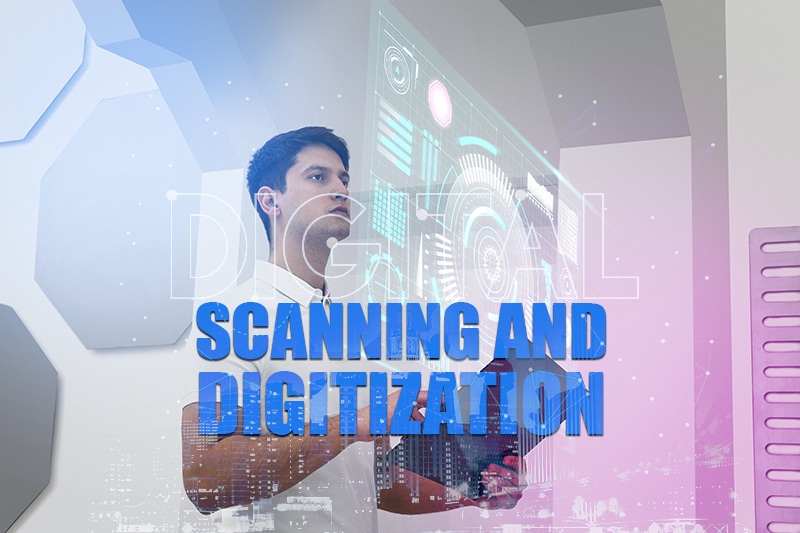Prior to the digital age, businesses relied heavily on paper-based documents and manual processes for record-keeping, document management, and communication. This often resulted in errors, inefficiencies, and difficulties in accessing important information. Document scanning services and digitization are two important processes that have revolutionized the way businesses handle documents and data by making it easier to create, store, and access information in a digital format.
Although they are two different processes, scanning and digitization are often used interchangeably. Scanning is the process of creating a digital image of a physical document, while digitization involves converting that digital image into an editable format using Optical Character Recognition (OCR) software. Let’s take a look at these processes in greater detail to understand how they differ.
Document Scanning Process
Scanning or document imaging refers to the process of converting physical documents into digital images using a scanner. Scanners use optical sensors to capture the visual information on the page and convert it into a digital image which is essentially a picture of the original document. The digital image can be saved as a file on a computer or other electronic device, and viewed, printed, or shared electronically.
A scanned image is typically a static representation of the original document and cannot be edited directly. However, there are tools and software available that allow users to convert scanned images into editable text, which can be modified and manipulated as needed.
Many industries use document scanning services to streamline their processes, reduce their storage costs, and enhance the security and accessibility of their documents. By going paperless, businesses can address multiple challenges and save considerable time and money. Both large and small businesses can rely on a document scanning company to manage their project, leverage advanced technology, and simplify their processes by fully embracing paperless operations.
Document Digitization Process
Document digitization is the process of converting physical documents into digital format. This can be done by scanning paper documents, capturing electronic documents, or by using a combination of both. Similar to document scanning, the goal of document digitization is to make information more accessible, searchable, and shareable, while reducing the need for physical storage space and manual document handling.
The first step in the digitization process is preparing the documents for scanning. Staples, paper clips, and other obstructions are removed, and the documents are sorted and organized. The documents are then scanned using a scanning device, scanning app, or scanning software. The resulting digital images are saved as files in the designated location. To make them easier to find and retrieve, the digital files are indexed by assigning metadata, such as document type, date, author, and keywords to each.
Once documents are digitized, OCR, document redaction, and automated retention tracking can be used to further enhance document management and compliance with data privacy regulations.
OCR software converts the scanned images into searchable and editable text. Digitized documents can be stored safely in a document management system or cloud-based storage solution, and easily retrieved, processed, and shared.
Document redaction involves selectively removing or obscuring sensitive information from a document, such as social security numbers, bank account numbers, or other personal identifiers. This is done to protect the privacy of individuals and comply with data protection regulations.
After using document management software, automated retention tracking involves tracking the lifecycle of documents and ensuring that they are retained for the appropriate amount of time based on legal, regulatory, or business requirements.
Scanning and Digitization -Trends and Benefits
Both document scanning and digitization have revolutionized the way businesses handle documents and data by making it easier to create, store, and access information in a digital format. Grand View Research estimates that the global digital transformation market size, which was valued at USD 731.13 billion in 2022, is anticipated to witness a CAGR of 26.7% during 2023-2030. The market growth can be attributed to the growing adoption of cutting-edge technologies such as cloud, big data analytics, and Artificial Intelligence (AI), among others.
Due to the benefits they offer in terms of time and cost savings, increased efficiency, and streamlined workflows, these processes have been widely adopted by various industries such as healthcare, banking, legal, real estate, government, education, retail, manufacturing and finance.
Here are the key ways scanning and digitization benefit businesses:
- Improved efficiency: Digitization allows businesses to automate manual processes and streamline workflows. This reduces the time and resources required to perform routine tasks, such as data entry, document retrieval, and record-keeping.
- Improved collaboration: Digital documents and data can be easily shared and accessed by multiple users, regardless of location. This makes collaboration easier, faster, and more efficient, allowing teams to work together seamlessly.
- Enhanced data security: Digital documents and data can be stored securely in the cloud or on servers, protecting them from loss, theft, or damage. This helps businesses to maintain the integrity and confidentiality of sensitive information.
- Increased productivity: With digital data and documents, businesses can quickly and easily access information, reducing the time required for finding and processing information. This increases productivity and promotes faster decision-making.
- Cost savings: Digitization can significantly reduce the cost of printing, storage, and paper-based processes. This results in cost savings for businesses in the long term.
The COVID-19 pandemic was an eye-opener for the business community which struggled to stay relevant despite all the social distancing, lockdown, work from home, and other challenges. Organizations that had digital strategies in place were able to face the challenges more successfully than those that did not. Furthermore, as the world becomes increasingly digital, businesses simply cannot ignore new digital trends. Partnering with a technologically advanced document scanning company is a practical way for businesses to embrace digitization, improve performance, boost efficiency, minimize operational costs, and stay competitive.
If you are looking for cost-effective document scanning services, give us a call at 1-800-670-2809!




